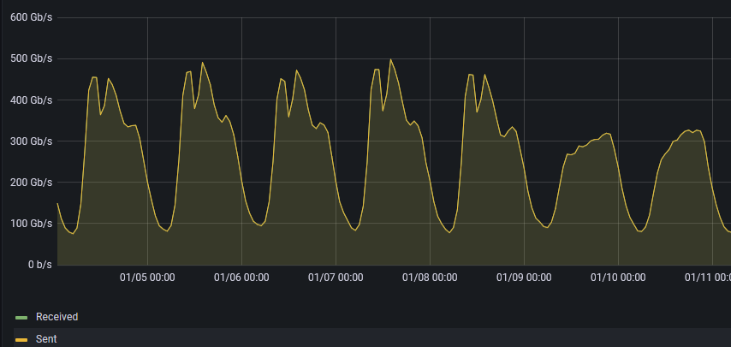The increase in Internet traffic in our country continued in 2021. This is according to figures from BNIX, the national Internet exchange point through which a large proportion of Belgian Internet traffic passes. Both average traffic and peaks were higher in 2021 than in 2020, which itself was an absolute record year. Currently, operator Belnet is completely revamping the BNIX platform, in part to be prepared for future data surges.
Last year, Belnet recorded an average data traffic of 224 gigabits per second on the BNIX platform, up three percent compared to the previous year. 'Despite the unprecedented Internet peaks of 2020, we have not seen Internet traffic drop in 2021,' points out Stefan Gulinck, as Network Architect at Belnet co-responsible for BNIX. 'On the contrary, where BNIX did not cross the 600 gigabit per second mark for the first time until the very end of 2020, by the spring of 2021 this was already the most normal thing in the world. In those months, we recorded peaks above 600 Gbit/s on weekdays. For comparison, this is equivalent to all the residents of Bruges streaming a video in HD at the same time. On 15 February, around noon, the counter even indicated 638 Gbit/s: never before had so much data traffic been exchanged in one second via the Belgian Internet exchange.'

Overview of all of 2021. The strict COVID-19 measures in the spring are evident. In the summer we see a decline, but not to the low levels of the past.
Sustained high plateau from January to April
The strict COVID-19 measures in the spring of 2021 are evident in the BNIX graphs. From January to April, traffic is at a high plateau and only begins to weaken from May. The moment COVID-19 strengthens its hold on the country again, there is another increase. But, in line with the less strict measures, the peaks of spring are no longer reached.
Stefan Gulinck: 'Although working from home has a big impact on our figures, it is noticeable that traffic in summer is also higher than before. This clearly shows that our information society is pushing the lower limit of our data consumption upwards year after year. Just how connected Belgians are today can be seen from the fact that Internet traffic is now very high from 8am to 10pm. This also confirms the broader trend that the line between professional and personal life is becoming increasingly blurred.'

Chart for the week of 5 January 2021. On weekdays, Internet traffic only drops sharply after 10pm. On weekends, we clearly see a different pattern.
Ready for the future As the 'roundabout' of Belgian Internet traffic, BNIX organises the data exchange between almost 60 participants. Via BNIX, Internet traffic on all highways reaches just about all Belgian private and business end users quickly and efficiently. Given this crucial position, Belnet is currently revamping the entire BNIX platform, among other things with the ever-increasing data flows in mind.
Dirk Haex, Technical Director at Belnet: 'Digitalisation continues to advance. Working from home will continue to form part of the new hybrid way of working, and the continued rush to the cloud will also still greatly increase the need for bandwidth. Likewise, consumer data consumption will continue to rise – just look at our ever-increasing image quality requirements when it comes to streaming and the huge rise of online gaming. It is up to Belnet, as the operator of the BNIX platform, to be forward-looking in this regard. Already last year, BNIX proved resilient to the unexpected challenges posed by COVID-19. With the current renewal, Belnet is preparing this crucial national infrastructure in the best possible way for new trends that the future undoubtedly holds.'